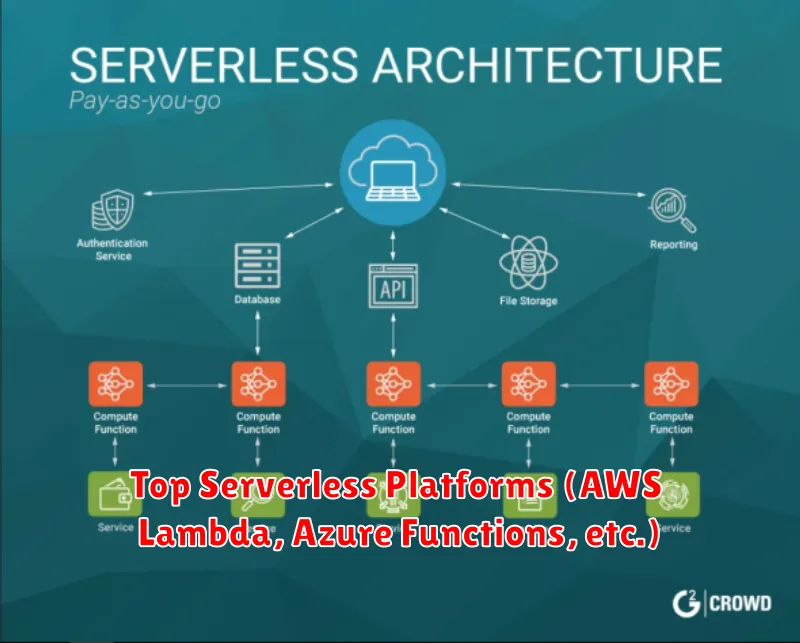In today’s rapidly evolving technological landscape, serverless architecture has emerged as a transformative approach to software development and deployment. This innovative paradigm shifts the focus from managing servers to purely focusing on code, offering significant advantages in terms of scalability, cost-efficiency, and developer productivity. This article delves into the core concepts of serverless architecture, exploring its definition, key characteristics, and the compelling reasons why it has become a crucial consideration for modern businesses and developers alike. Understanding serverless computing and its implications is essential for staying competitive in the current digital era.
Moving beyond traditional server-based infrastructure, serverless architecture offers a compelling alternative that abstracts away the complexities of server management. By leveraging Function-as-a-Service (FaaS) platforms, developers can deploy individual functions or microservices that execute on demand, scaling automatically in response to real-time traffic fluctuations. This eliminates the need for provisioning and maintaining servers, reducing operational overhead and allowing developers to concentrate on writing efficient and performant code. This article will explore the key benefits of embracing a serverless approach, including improved agility, reduced latency, and enhanced resilience, showcasing why it matters in the context of modern application development and deployment.
Understanding Serverless Computing
Serverless computing is a cloud computing execution model where the cloud provider dynamically manages the allocation of computing resources. Pricing is based on the actual amount of resources consumed, rather than pre-purchased units of capacity. It’s important to understand that serverless doesn’t mean “no servers.” Servers are still involved, but their management is abstracted away from the developer.
In a serverless architecture, developers write and deploy code as individual functions, often referred to as “functions as a service” (FaaS). These functions are triggered by events, such as HTTP requests, database updates, or scheduled tasks. The cloud provider automatically provisions the necessary resources to execute the function, and then de-allocates them once the function completes. This eliminates the need for developers to manage servers, operating systems, or scaling infrastructure.
Key benefits of serverless computing include scalability, cost-effectiveness, and faster development cycles. Serverless platforms automatically scale applications up or down based on demand, ensuring optimal performance without manual intervention. The pay-as-you-go pricing model reduces costs by eliminating the need to pay for idle server time. Finally, the simplified operational model allows developers to focus on writing code and delivering features more quickly.
How It Differs from Traditional Hosting
Serverless architecture diverges significantly from traditional hosting models. In traditional hosting, you rent server space, whether a physical server or a virtual machine. You are responsible for managing the operating system, security patches, and scaling resources to meet demand. This often leads to paying for unused capacity or scrambling to add resources during traffic spikes.
Serverless computing, however, abstracts away server management. You deploy your code as functions, and the cloud provider dynamically allocates resources as needed. You only pay for the compute time your functions consume, eliminating the cost of idle servers. Scalability is handled automatically, ensuring your application can handle fluctuations in traffic without manual intervention.
| Feature | Traditional Hosting | Serverless |
|---|---|---|
| Server Management | User responsibility | Provider responsibility |
| Cost | Pay for reserved capacity | Pay per execution |
| Scaling | Manual or configured | Automatic |
Benefits for Developers and Businesses
Serverless architecture offers significant advantages for both developers and businesses. For developers, it dramatically reduces operational overhead. They no longer need to manage servers, handle scaling, or worry about infrastructure maintenance. This allows them to focus on writing code and delivering features faster. Increased productivity is a key benefit, as developers can iterate and deploy more rapidly.
From a business perspective, serverless computing offers cost savings. Businesses only pay for the compute time their applications actually use, eliminating the expense of idle servers. Scalability is also a major advantage. Serverless platforms automatically scale applications up or down based on demand, ensuring optimal performance and resource utilization. This inherent scalability makes it easier for businesses to handle traffic spikes and fluctuating workloads.
Furthermore, serverless encourages faster time to market. The simplified deployment process allows businesses to release new features and updates more quickly, gaining a competitive edge. The reduced operational burden also frees up resources that can be invested in innovation and other strategic initiatives.
Top Serverless Platforms (AWS Lambda, Azure Functions, etc.)

Several leading cloud providers offer robust serverless computing platforms. Amazon Web Services (AWS) Lambda is a pioneer in this space, allowing you to run code without provisioning or managing servers. You upload your code, and Lambda takes care of everything else, from scaling to security.
Microsoft Azure Functions is another popular choice, providing a similar event-driven compute experience. It integrates tightly with other Azure services, making it a strong option for businesses already invested in the Microsoft ecosystem.
Google Cloud Functions rounds out the “big three” cloud providers’ serverless offerings. Known for its developer-friendly tools and focus on performance, it’s a compelling option for various workloads.
Beyond these major players, other platforms cater to specific needs and preferences. These include solutions like IBM Cloud Functions, Apache OpenWhisk (an open-source platform), and offerings from smaller cloud providers, giving developers a diverse range of options to choose from based on their specific project requirements.
Common Serverless Use Cases
Serverless computing’s flexibility lends itself to a variety of use cases. Backends for web and mobile applications are a popular choice, allowing developers to focus on front-end development and business logic without managing servers. Serverless functions can handle API requests, database interactions, and user authentication seamlessly.
Real-time data processing is another strong suit. Serverless architectures can efficiently process streams of data from IoT devices, social media feeds, and other sources. This enables applications to react quickly to changing conditions and provide up-to-the-minute insights.
Scheduled tasks benefit from serverless efficiency. Tasks like database backups, report generation, and cleanup routines can be automated without the need for constantly running servers, reducing operational overhead and costs.
Event-driven applications thrive in a serverless environment. Functions can be triggered by specific events like file uploads, database changes, or messages in a queue. This allows for highly responsive and scalable systems that only consume resources when needed.
Performance and Latency Considerations

While serverless architectures offer numerous advantages, performance and latency require careful consideration. Cold starts can introduce noticeable delays when a function hasn’t been invoked recently. This occurs because the cloud provider needs to spin up a new instance of the function. Subsequent invocations benefit from warm starts, which are significantly faster as the function instance is already running.
Function location plays a crucial role in minimizing latency. Deploying functions closer to the users or data sources they interact with can significantly reduce the time it takes for requests to be processed and returned. Network latency can be a major contributing factor to overall application performance, especially in geographically dispersed systems.
Optimizing function code for execution speed is also essential. Minimizing dependencies and using efficient algorithms can reduce the amount of time a function takes to complete its task. Monitoring and profiling tools can help identify performance bottlenecks and inform optimization efforts.
Challenges and Limitations
While serverless architecture offers numerous advantages, it also presents certain challenges and limitations that organizations should consider. Vendor lock-in is a potential concern, as migrating between serverless providers can be complex due to variations in services and tooling.
Cold starts can introduce latency when a function is invoked for the first time or after a period of inactivity. Optimizing functions and leveraging provisioned concurrency can help mitigate this issue, but it remains a factor.
Debugging and monitoring serverless applications can be more challenging than traditional applications due to their distributed nature. Specialized tools and techniques are often required to effectively troubleshoot issues and gain visibility into application performance.
Statelessness, while a core principle of serverless, can also be a limitation. Maintaining application state across function invocations necessitates reliance on external services like databases or caching mechanisms.

